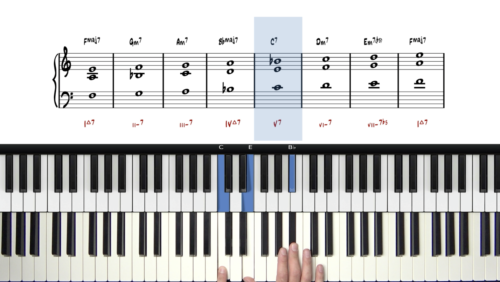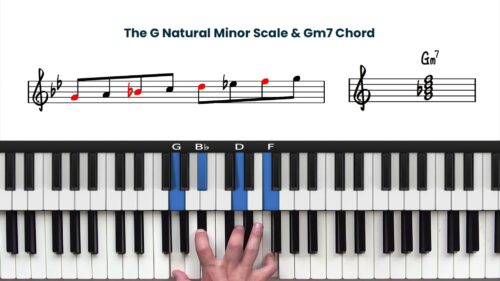Eb Major Spread Voicing Drills
In this lesson we dive into the key of Eb major covering the essential harmonic components including the major scale, diatonic 7th chords, and common progressions like the 2-5-1 and 3-6-2-5-1.
By the end of this lesson, you will be able to visualise the Eb major diatonic 7th chords in both root and spread voicings.
Eb Major Scale & Diatonic 7th Chords
We begin by familiarising ourselves with the Eb major scale played over two octaves. From each degree of the scale we can build the diatonic seventh chords:
Ebmaj7 / F-7 / G-7 / Abmaj7 / Bb7 / C-7 / D-7b5.
Understanding the structure and function of these chords will help you to quickly analyse jazz standards and group together related blocks of harmony.
Root Position to Spread Voicings
Root position chords are where all chord notes are stacked sequentially and all played within the space of an octave. While occasionally used in jazz piano performance, they typically can sound too dense and unbalanced and so instead we turn root position chords into 2-handed spread voicings.
By learning to play spread voicings — where the notes of the chord are distributed across both hands — we achieve a more resonant and balanced sound. This technique is essential for harmonising and arranging jazz standards.
Mastering Common Jazz Progressions
We explore the 2-5-1 progression (F-7, Bb7, and Ebmaj7) and the 3-6-2-5-1 progression (G-7, C7, F-7, Bb7, and Ebmaj7). These common progressions are the building blocks of many jazz tunes. Isolating and practicing these progressions will significantly improve your ability to navigate and interpret jazz standards.
Lesson Downloads
-
Eb Major Diatonic Harmony File Type: pdf
Practice Tips
-
Scale and Chord Practice: Start each practice session by playing the Eb major scale and the diatonic seventh chords in root position. This reinforces your understanding of the key’s harmonic structure.
-
Create Spread Voicings: Transition from root position to spread voicings for each chord. Move to root into the lower registers and play the 3rds and 7ths in your right to create a more balanced sound.
-
Practice Common Progressions: Isolate and practice the 2-5-1 and 3-6-2-5-1 progressions using 3-note spread voicings. This will enhance your fluidity in moving between chords when playing jazz standards.
- Consistent Practice: Dedicate 10-15 minutes at the start of each practice session to these drills. Regular practice will solidify your understanding and help you to visualise these essential harmonic components.







